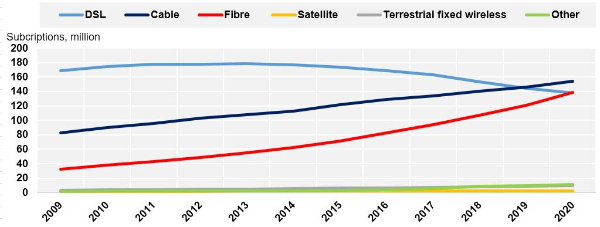High-speed Fibre Overtakes DSL As OECD Countries Add 21 Million Fixed Broadband Connections In Pandemic Year
High-speed fibre Internet subscriptions surpassed copper-wire DSL connections across OECD countries for the first time in 2020 as the need to move work and home life activities online during the COVID-19 pandemic led to a record 21.15 million new fixed broadband connections (including fibre, DSL, cable and others) in the year to end-December 2020.
The latest update to the OECD's broadband portal shows that fibre now exceeds 30% of fixed broadband subscriptions across the OECD’s 38 member countries, up from 12% a decade ago, and is by far the fastest growing broadband technology, with subscriptions up 14% in 2020 from 2019, outpacing a 5% rise in overall fixed broadband subscriptions.
While cable remains the predominant fixed broadband technology, accounting for 34% of subscriptions across OECD countries with a rise of 5.6% in 2020, fibre is steadily replacing DSL subscriptions, which have dropped by 10% over the past two years.
Austria, Belgium, Chile, Ireland, Israel and the United Kingdom all increased their fibre connections by more than 50% in 2020. In more and more OECD countries, the majority of broadband connections are now fibre, with the share of fibre in total broadband above 50% in Finland, Iceland, Luxembourg, New Zealand, Norway and Portugal, and exceeding 70% in Japan, Korea, Latvia, Lithuania, Spain and Sweden.
Progression in fixed broadband subscriptions by technology

Overall, fixed broadband subscriptions in OECD countries totalled 454 million as of December 2020, up from 433 million a year earlier, and averaged 33.2 subscriptions per 100 inhabitants. Switzerland led the pack with a penetration rate of 47.5 subscriptions per 100 people, followed by France (45.6%), Norway (44.6%) and Denmark (44.2%).
Mobile data usage soared by more than 30% on average in 2020 across the 35 OECD countries for which data were available, with 29 countries showing an increase of over 20%.
Finland remains the OECD champion for data consumption at a total of 31 Gigabytes (GB) per subscriber per month, followed by Austria (25.8 GB), Latvia (23 GB), Lithuania (20.5 GB), Iceland (16.7 GB), Estonia (16 GB), Chile (12.8 GB) and Sweden (12 GB). Eight countries – Costa Rica, Czech Republic, Greece, Iceland, Italy, Lithuania, Spain and Turkey – saw significant growth of 45% or more in data usage over 2020. On average, users downloaded 7.5 GB of data per month per subscription in 2020, up from 5.8 GB in 2019 in those countries for which data was available.
Mobile broadband subscriptions grew by almost 3% in 2020 across OECD countries. Mobile Internet penetration is highest in Japan, Estonia and Finland, with subscriptions per 100 inhabitants at 185%, 165% and 156%, respectively.
Data on machine-to-machine (M2M) communications show that Sweden and Austria remain the leaders in the number of M2M SIM cards per 100 inhabitants. Sweden has 163 M2M SIM cards per 100 inhabitants – a much higher level than most OECD countries that provided data – due in part to the use of these SIM cards in other countries by a Swedish operator.
Note that OECD broadband statistics now cover 38 countries with the inclusion of new member Costa Rica, whose data have now been added to historical OECD totals, averages and growth rates where possible.
Download broadband data, charts and penetration maps by country at http://oe.cd/broadband.


 John P. Ruehl, IMI: Alongside China’s, Which Social Credit Systems Are Developing?
John P. Ruehl, IMI: Alongside China’s, Which Social Credit Systems Are Developing? Palestinian Journalists Protection Center: Farewell To The Last Lens - The Story Of Journalist Yahya Sobeih’s Martyrdom
Palestinian Journalists Protection Center: Farewell To The Last Lens - The Story Of Journalist Yahya Sobeih’s Martyrdom UN News: Pandemics To Pollution - WHO Assembly Delivers Landmark Health Decisions
UN News: Pandemics To Pollution - WHO Assembly Delivers Landmark Health Decisions NZDF: New Zealand-led Task Force, With Royal Navy, Seizes NZ$1b Worth Of Drugs In Arabian Sea
NZDF: New Zealand-led Task Force, With Royal Navy, Seizes NZ$1b Worth Of Drugs In Arabian Sea ACI Asia Pacific: Air Connectivity Ranking - Asia-Pacific Reports 13% Growth; Middle East Leads With 28%
ACI Asia Pacific: Air Connectivity Ranking - Asia-Pacific Reports 13% Growth; Middle East Leads With 28% Save The Children: Ukraine - Air Raid Sirens Halted One In Every Five Lessons This School Year
Save The Children: Ukraine - Air Raid Sirens Halted One In Every Five Lessons This School Year